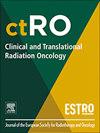影像引导下口腔头颈部近距离放射治疗剂量计算方法及临床剂量反应比较
IF 2.7
3区 医学
Q3 ONCOLOGY
引用次数: 0
摘要
基于模型的剂量计算算法(MBDCAs)在近距离治疗中的应用越来越多,但在剂量-反应分析中仍缺乏考虑。本研究旨在评估TG-43和MBDCA剂量测定之间的相关性,并报道口腔近距离治疗的临床结果。方法我们分析了2012年至2021年在我院治疗的158例口腔癌患者。中位随访80个月(2-152个月),报告了生存结果和毒性(软组织坏死、骨放射性坏死、粘膜炎、口干)。所有基于TG-43的临床治疗计划使用整合到计划系统中的MBDCA重新计算。考虑到几个目标体积、组织和骨剂量参数的差异进行评估。研究了与毒性增加相关的临床结果和阈值的参数相关性。结果局部累积复发率为21%,软组织坏死率为22%,骨坏死率为28%,口干率为79%。观察到MBDCA和TG-43之间存在实质性差异,特别是在高剂量区域,变化高达19%。观察到许多剂量-毒性相关性,如骨放射性坏死(骨D5ccm≥59.3 Gy时为1.6%对10.3%),软组织坏死(D5ccm≥87.7 Gy时为16%对32%)和局部复发(剂量不均匀比和lt时为13%对25%);0.29)(使用MBDCA)。靶体积≥10.2-11.8ccm与软组织坏死和粘膜炎发生率增加相关。TG-43和MBDCA的剂量学阈值和相关性存在差异。结论对于口腔近距离放射治疗,确定了几个与毒性增加相关的重要剂量阈值。用于相应剂量计算的mbdca应推广应用于临床。本文章由计算机程序翻译,如有差异,请以英文原文为准。
Comparison of dose calculation approaches and clinical dose–response in image-guided head&neck brachytherapy of the oral cavity
Purpose
Model-based dose calculation algorithms (MBDCAs) are increasingly applied in brachytherapy, but their considerations in dose–response analyses is still lacking. This study aimed to assess correlations between both TG-43 and MBDCA dosimetry and reports on clinical outcomes for oral cavity brachytherapy.
Methods
We considered 158 patients with oral cavity cancer treated in our institution between 2012 and 2021. Survival outcomes and toxicity (soft tissue necrosis, osteoradionecrosis, mucositis, xerostomia) were reported for a median follow-up of 80 months (2–152 months). All clinical, TG-43 based treatment plans were re-calculated using a MBDCA integrated into our planning system. Differences considering several target volume, tissue, and bone dose parameters were evaluated. Parameter correlations with clinical outcomes and thresholds associated with increased toxicity were investigated.
Results
Cumulative local recurrence, soft-tissue necrosis, osteoradionecrosis, mucositis, and xerostomia rate were 21 %, 22 %, 28 % and 79 % considering all patients. Substantial differences between MBDCA and TG-43 were observed, especially regarding high-dose areas with changes up to 19 %. A number of dose-toxicity correlations were observed, as for osteoradionecrosis (1.6 % vs. 10.3 % for bone D2ccm ≥ 59.3 Gy), soft tissue necrosis (16 % vs. 32 % for tissue D5ccm ≥ 87.7 Gy), and local recurrence (13 % vs. 25 % for dose non-uniformity ratio < 0.29) (using the MBDCA). Target volumes ≥ 10.2–11.8ccm were associated with increased rates of soft tissue necrosis and mucositis. Dosimetric thresholds and correlations differed between TG-43 and MBDCA.
Conclusion
For oral cavity brachytherapy, several important dosimetric thresholds associated with increased toxicity were determined. MBDCAs for corresponding dose calculations should be advanced and used in clinical practice.
求助全文
通过发布文献求助,成功后即可免费获取论文全文。
去求助
来源期刊

Clinical and Translational Radiation Oncology
Medicine-Radiology, Nuclear Medicine and Imaging
CiteScore
5.30
自引率
3.20%
发文量
114
审稿时长
40 days
 求助内容:
求助内容: 应助结果提醒方式:
应助结果提醒方式:


